The article “Safe Stabling: Protect the People” by Nancy Loving DVM shares a few tips and suggestions on how people can keep themselves safe around horses and in barns. Her fun photo challenge first caught my attention, as we have done similar challenges (as seen here). My career in designing horse farms has continuously focused on how to design for the safety of both horse and handler. I wanted to add some additional tips on how stable design can help keep both people and animals safe. One could write a book on the subject, and I have in fact. My book Healthy Stables by Design (www.healthystablesbydesign.com) has been released. But for now, I’ll name eight areas of concern: Circulation, Fire Separation, Ventilation, Finishes, Layout, Materials, Orientation, and Natural Light (see diagram below). I have shared one example under each, but in truth the list is virtually limitless. Feel free to comment with your own suggestions. Let’s build a list together and see how far we can take it.
Circulation: In planning the farm and the location of the barn relative to paddocks, roadways, service lanes, and lead paths, always try to bring people, vehicles, and horses as close together as possible without crossing paths. They should be separate, but still efficient (as all circulation routes are costs in terms of installation, maintenance and operation).
Fire Separation: It goes without saying that fire safety is a major concern around horse barns. Both how you design to prevent and contain a fire once it happens is important. I always suggest isolating hay, bedding, and flammable products (such as fuel and machinery) from the barn by placing them in a separate structure. Whenever you can, consider fire separations. For example, I frequently design a fire separation that isolates the stall area from the service areas of the barn by using pocket doors to close off the aisle. They serve to isolate the “human areas,” such as tack room, laundry, lounge, or office, from the “horse areas.” By doing so, they separate the areas of high risk from the horses. If there is a fire, the fire separation works to contain the smoke and slow the spread of the fire in order to give you more time to get the horses out.
Ventilation: The most important health concern for your horses. Natural ventilation, including vertical ventilation, is the most important design consideration. Design the barn to be a natural machine, not just a static structure. Use the Bernoulli principle and the chimney effect to create that. Place the barn perpendicular to the summer prevailing breeze in order to take the most advantage of the site.
Finishes: Avoid finishes that will collect dirt, moisture, bacteria, etc. For that reason, we do not advise using finishes that are not easily washable or do not drain well.
Layout (site and building): Consider the natural slope and drainage of the land. Place the barn on a pad that is at least 18″ to 2 ft above finish grade. Ideally, one wants the ground to slope away from the finish floor of the barn, as this will aid with drainage.
Materials: Never use exposed concrete if you can help it, unless adequately protected (rubber mats, etc). The use of concrete is especially bad in stalls and wash/grooming areas, where horse may be standing for long periods of time.
Orientation: Orientation is important for natural ventilation, but it’s also important to consider the angles of the sun during different times of the year for natural light. Protection from the sun might also be a concern, so consider the design of openings, overhangs, view corridors, security, etc.
Natural light: When designing a barn for health and safety, natural light is probably only second to natural ventilation in importance. The horse was meant to live in nature. Natural light is key to the natural cycling of broodmares in a thoroughbred-breeding farm, but it also helps promote the health of any horse. Lighting is also a safety and cost concern. The more you can use natural light to light your barn, the less you need to depend on man-made light, which is an operational cost but also a fire hazard.
These are 8 of my favorite health and safety design principles. Read the article by Nancy Loving, look at your own farm and try to add to the list I have started above. We can all have a little fun with it and maybe learn a few pointers while we are at it.
Good luck and I look forward to your responses.
